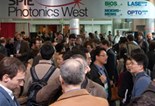SPIE Photonics West To Bring Reports On New Life-Improving Photonics, Biomedical Optics Technologies To San Francisco

Bellingham, WA -- Advances that enable new treatments for cancer, better energy-efficient lighting, more robust communications systems, and other quality-of-life improvements will take center stage next month at SPIE Photonics West in San Francisco, Calif. The event also launches celebrations of the golden anniversary of the laser, one of the most important technologies ever developed, with many impacts in everyday life as well as in scientific research.
SPIE Photonics West, the world's largest international photonics, laser, and biomedical optics event, will run 23-28 January at Moscone Center. Organizers expect 18,000 people to attend during the week.
The weeklong international symposium will include more than 3,600 technical presentations, 2 exhibitions, 60 professional development courses and workshops, and numerous networking events.
Topics will cover biophotonic medical advances, optoelectronics for LEDs, solid-state lighting, optical communications, miniaturization of optics for commercial applications, and the full range of laser technologies, including medical, fiber, solid-state, high-energy, and semiconductor.
More than 1,120 exhibiting companies will show at the annual exhibition running 26-28 January. Photonics West is a popular venue for new product launches, with approximately 175 scheduled this year. Displays will include all types of lasers and hundreds of devices, components, and systems for imaging, sensing, and industrial applications.
The Biomedical Optics exhibition is also larger than ever, with 175 companies showing innovations and new products for molecular and microscopic imaging, therapeutic lasers and other devices for biomedical optics, nano/biophotonics, biosensors, and spectroscopic analysis. Dates are 23-24 January.
Highlights among Photonics West's many laser celebration events are a "Cirque du Lasaire" welcome reception, an exhibition-hall display of laser equipment from across the technology's 50 years, and multimedia displays showcasing the latest advances in laser R&D. SPIE is celebrating the anniversary of the invention of the first laser, by Theodore Maiman at Hughes Research Labs. in May 1960, through its Advancing the Laser tribute and as a Founding Partner and Sponsor of LaserFest.
Events accessible with free registration to the exhibition include industry expert panels on the solar market, trends and opportunities in optics and photonics, the laser industry, and silicon photonics for optical interconnects.
The top international photonics conferences composing the Photonics West technical program are organized into four symposia: Biomedical Optics (BiOS), Lasers and Applications (LASE), MOEMS-MEMS/Micro- and Nanofabrication (MOEMS-MEMS), and Optoelectronic Materials, Devices, and Applications (OPTO).
Featured talks by leading international researchers will include:
- A popular BiOS hot topics session, this year featuring reports on breast cancer therapy, intravascular OCT, molecular imaging, spectroscopy, and microscopy
- MOEMS-MEMS plenary talks on artificial retinas, deformable mirrors, and health-care and environmental sensing opportunities for microsystems
- OPTO plenary talks on nonpolar/semipolar LEDs and other solid-state lighting advances
- LASE plenary talks on attosecond-Ångstrom science and ultrafast fiber technology.
Winners of the 2009 Prism Awards for Photonics Innovation, cosponsored by SPIE and Laurin Publishing, will be announced at Photonics West. The awards recognize the best in innovative technology in optics and photonics. Winners in nine categories are selected by panel of independent, expert judges. Information including the list of finalists is at photonicsprismaward.com.
Among numerous networking and other events forwarding the Society's mission of promoting optics and photonics around the world is a presentation on the vital role that the education of girls plays in sustainable development in Africa, Asia, and Latin America. The presentation will given at a Women in Optics reception.
SOURCE: SPIE
